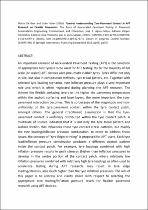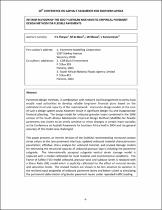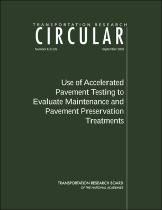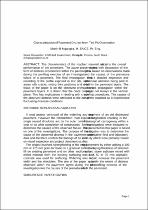 ResearchSpace
ResearchSpace
Towards Understanding Tyre-Pavement Contact in APT Research on Flexible Pavements
JavaScript is disabled for your browser. Some features of this site may not work without it.
- ResearchSpace
- →
- Research Publications/Outputs
- →
- Journal Articles
- →
- View Item
| dc.contributor.author |
De Beer, Morris

|
|
| dc.contributor.author |
Fisher, Colin

|
|
| dc.date.accessioned | 2017-07-28T08:57:58Z | |
| dc.date.available | 2017-07-28T08:57:58Z | |
| dc.date.issued | 2016-09 | |
| dc.identifier.citation | De Beer, M. and Fisher, C. 2016. Towards Understanding Tyre-Pavement Contact in APT Research on Flexible Pavements. 5th International Conference on Accelerated Pavement Testing, San Jose, Costa Rica, 19-21 September 2016. http://dx.doi.org/10.1007/978-3-319-42797-3_32 | en_US |
| dc.identifier.isbn | 978-3-319-42796-6 | |
| dc.identifier.uri | https://trid.trb.org/view.aspx?id=1448484 | |
| dc.identifier.uri | https://link.springer.com/chapter/10.1007/978-3-319-42797-3_32 | |
| dc.identifier.uri | http://hdl.handle.net/10204/9298 | |
| dc.description | Copyright: 2016 Springer. Due to copyright restrictions, the attached PDF file only contains the abstract of the full text item. For access to the full text item, please consult the publisher's website. | en_US |
| dc.description.abstract | An important element of Accelerated Pavement Testing (APT) is the selection of appropriate test tyre(s) to be used for APT testing. By far the majority of full scale (or scaled) APT devices uses pneumatic rubber tyres. Tyres differ not only in size, but also in composition stiffness, tyre tread patters, etc. Together with selected tyre loading scenarios, tyre inflation pressure plays a very important role and which is often neglected during planning the APT research. The thinner the flexible surfacing layers or the higher the pavement temperature within the asphalt surfacing and base layers, the more important the tyre-pavement interaction becomes. This is so because of the magnitude and non-uniformity of the tyre-pavement contact within the tyre contact patch, amongst others. The general (traditional) assumption is that the tyre-pavement contact is uniformly distributed within the tyre contact patch. A multitude of studies indicated that it is not only the tyre tread pattern and surface friction that influences these tyre contact stress patterns, but mainly the tyre loading/inflation pressure combination. In order to address these issues, the concept of “tyre fingerprinting” is proposed for APT users. Each tyre load/inflation pressure combination produces a different contact pattern inside the contact patch. For example, tyre loadings combined with high inflation pressure results in peak stresses (higher than inflation pressure) to develop in the centre portion of the contact patch, where relatively low inflation pressures combined with relatively high tyre loadings as often used to accelerate testing during APT research, may result in tyre edge loading/stresses, also much higher than the tyre inflation pressures. The aim of this paper is to address and clarify above with respect to selecting the appropriate tyre loading/inflation pressure levels for flexible pavement research using APT devices. | en_US |
| dc.language.iso | en | en_US |
| dc.publisher | Springer | en_US |
| dc.relation.ispartofseries | Worklist;18690 | |
| dc.subject | Tyre | en_US |
| dc.subject | Flexible | en_US |
| dc.subject | Pavement | en_US |
| dc.subject | Loading | en_US |
| dc.subject | Fingerprinting | en_US |
| dc.subject | Tyre-pavement contact stress | en_US |
| dc.subject | TPCS | en_US |
| dc.subject | Accelerated pavement testing | en_US |
| dc.subject | APT | en_US |
| dc.title | Towards Understanding Tyre-Pavement Contact in APT Research on Flexible Pavements | en_US |
| dc.type | Article | en_US |
| dc.identifier.apacitation | De Beer, M., & Fisher, C. (2016). Towards Understanding Tyre-Pavement Contact in APT Research on Flexible Pavements. http://hdl.handle.net/10204/9298 | en_ZA |
| dc.identifier.chicagocitation | De Beer, Morris, and Colin Fisher "Towards Understanding Tyre-Pavement Contact in APT Research on Flexible Pavements." (2016) http://hdl.handle.net/10204/9298 | en_ZA |
| dc.identifier.vancouvercitation | De Beer M, Fisher C. Towards Understanding Tyre-Pavement Contact in APT Research on Flexible Pavements. 2016; http://hdl.handle.net/10204/9298. | en_ZA |
| dc.identifier.ris | TY - Article AU - De Beer, Morris AU - Fisher, Colin AB - An important element of Accelerated Pavement Testing (APT) is the selection of appropriate test tyre(s) to be used for APT testing. By far the majority of full scale (or scaled) APT devices uses pneumatic rubber tyres. Tyres differ not only in size, but also in composition stiffness, tyre tread patters, etc. Together with selected tyre loading scenarios, tyre inflation pressure plays a very important role and which is often neglected during planning the APT research. The thinner the flexible surfacing layers or the higher the pavement temperature within the asphalt surfacing and base layers, the more important the tyre-pavement interaction becomes. This is so because of the magnitude and non-uniformity of the tyre-pavement contact within the tyre contact patch, amongst others. The general (traditional) assumption is that the tyre-pavement contact is uniformly distributed within the tyre contact patch. A multitude of studies indicated that it is not only the tyre tread pattern and surface friction that influences these tyre contact stress patterns, but mainly the tyre loading/inflation pressure combination. In order to address these issues, the concept of “tyre fingerprinting” is proposed for APT users. Each tyre load/inflation pressure combination produces a different contact pattern inside the contact patch. For example, tyre loadings combined with high inflation pressure results in peak stresses (higher than inflation pressure) to develop in the centre portion of the contact patch, where relatively low inflation pressures combined with relatively high tyre loadings as often used to accelerate testing during APT research, may result in tyre edge loading/stresses, also much higher than the tyre inflation pressures. The aim of this paper is to address and clarify above with respect to selecting the appropriate tyre loading/inflation pressure levels for flexible pavement research using APT devices. DA - 2016-09 DB - ResearchSpace DP - CSIR KW - Tyre KW - Flexible KW - Pavement KW - Loading KW - Fingerprinting KW - Tyre-pavement contact stress KW - TPCS KW - Accelerated pavement testing KW - APT LK - https://researchspace.csir.co.za PY - 2016 SM - 978-3-319-42796-6 T1 - Towards Understanding Tyre-Pavement Contact in APT Research on Flexible Pavements TI - Towards Understanding Tyre-Pavement Contact in APT Research on Flexible Pavements UR - http://hdl.handle.net/10204/9298 ER - | en_ZA |








